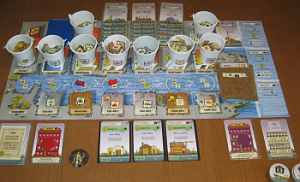Board Game History in a Nutshell
If you like modern, fun board games as much as I do (which is likely, since you’re reading this) and you haven’t read Dave Shapiro’s article written in 2003 entitled To Boldly Go…, then you owe it to yourself to do so. Take some time, as soon as your done here, to pay yourself back by going over to The Games Journal to read it.
While you’re there, click over to Lewis Pulsipher’s attempt at defining Euro-style (aka German) board games. He restricts his definition to games having these 13 characteristics. Quoting…
- Rarely take more than an hour to play.
- Simple rules.
- Only a few plausible or reasonable choices each turn.
- Uncertainty of information.
- No player elimination.
- Very pacific.
- Player interaction without overt conflict.
- Short intervals between playing (“down time”).
- There are not many pieces—cards, counters, etc.—for a player to manipulate in a given turn.
- Great visual interest.
- Abstract to the point that the “theme” appears to be tacked on.
- A dislike of dice.
- Positive scoring mechanisms.

I think I agree with most of these with the possible exception of #1. It’s difficult to play a game of Agricola or Le Havre in less than an hour, yet I don’t think anyone would for that reason cease to call it a Euro.
What do you think? If we imposed all of these conditions on the board game pool, how many would make the cut as true Euros?
